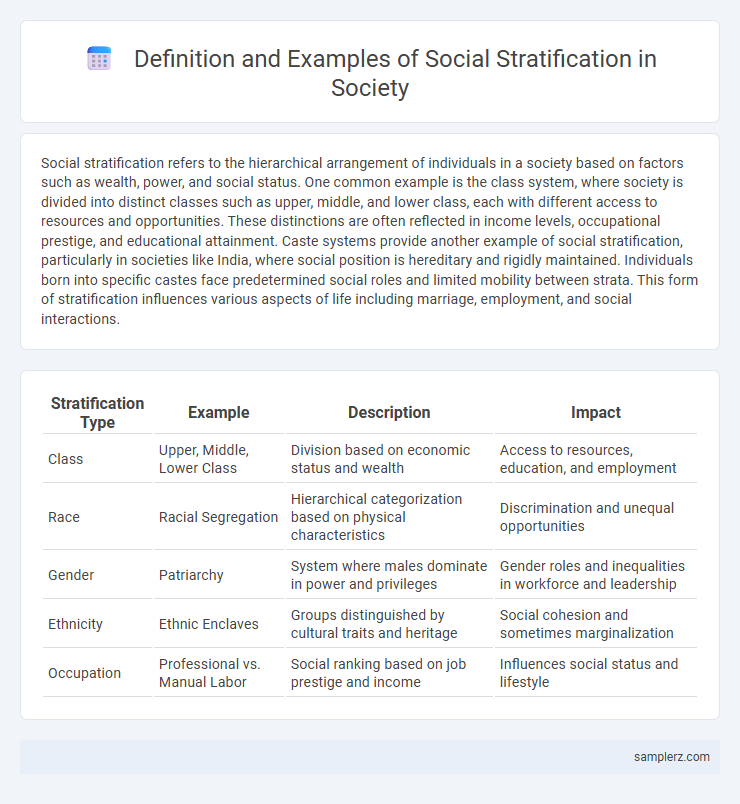Social stratification refers to the hierarchical arrangement of individuals in a society based on factors such as wealth, power, and social status. One common example is the class system, where society is divided into distinct classes such as upper, middle, and lower class, each with different access to resources and opportunities. These distinctions are often reflected in income levels, occupational prestige, and educational attainment. Caste systems provide another example of social stratification, particularly in societies like India, where social position is hereditary and rigidly maintained. Individuals born into specific castes face predetermined social roles and limited mobility between strata. This form of stratification influences various aspects of life including marriage, employment, and social interactions.
Table of Comparison
| Stratification Type | Example | Description | Impact |
|---|---|---|---|
| Class | Upper, Middle, Lower Class | Division based on economic status and wealth | Access to resources, education, and employment |
| Race | Racial Segregation | Hierarchical categorization based on physical characteristics | Discrimination and unequal opportunities |
| Gender | Patriarchy | System where males dominate in power and privileges | Gender roles and inequalities in workforce and leadership |
| Ethnicity | Ethnic Enclaves | Groups distinguished by cultural traits and heritage | Social cohesion and sometimes marginalization |
| Occupation | Professional vs. Manual Labor | Social ranking based on job prestige and income | Influences social status and lifestyle |
Historical Roots of Social Stratification
Social stratification has deep historical roots, often originating from the division of labor in early agrarian societies where surplus resources led to distinct social classes. Feudal systems in medieval Europe exemplify rigid hierarchical structures based on land ownership and hereditary privilege, reinforcing unequal access to power and wealth. These historical patterns established enduring social hierarchies still evident in modern socio-economic inequalities.
Caste Systems: Traditional Hierarchies
Caste systems represent a form of social stratification characterized by rigid hereditary groups that dictate individuals' social status, occupation, and marriage prospects. Predominantly found in countries like India, these traditional hierarchies enforce social segregation and limit mobility between castes. The entrenched nature of caste-based discrimination impacts access to education, employment, and political representation, perpetuating inequality across generations.
Class Structure in Modern Societies
Class structure in modern societies typically divides populations into upper, middle, and lower classes based on factors such as income, education, and occupation. Wealth concentration in the upper class enables greater access to resources and opportunities, while the middle class generally experiences economic stability and upward mobility. Persistent disparities in social capital and access to education reinforce stratification, limiting social mobility for lower-class individuals.
Economic Inequality and Social Mobility
Economic inequality manifests in disparities such as wage gaps and unequal access to resources, deeply influencing social stratification by creating distinct socioeconomic classes. Limited social mobility further entrenches these divisions, as individuals from lower-income families often face barriers to education and employment opportunities crucial for upward movement. Studies show that countries with higher economic inequality typically experience reduced social mobility, perpetuating a cycle of poverty and privilege across generations.
Racial and Ethnic Stratification
Racial and ethnic stratification manifests in unequal access to education, employment, and healthcare, disproportionately affecting minority groups such as African Americans, Latinos, and Native Americans. These systemic disparities reinforce social hierarchies, limiting upward social mobility and perpetuating economic inequality. Policies addressing affirmative action and anti-discrimination laws aim to reduce these structured imbalances in society.
Gender Roles and Stratified Societies
Gender roles are a primary example of social stratification, where societies assign different responsibilities and expectations based on gender, often privileging men over women in political, economic, and social power. In stratified societies, rigid gender norms reinforce inequality by limiting access to resources, education, and leadership opportunities for women and gender minorities. This systemic differentiation perpetuates unequal social status and restricts social mobility across gender lines.
Education as a Tool for Stratification
Education acts as a key mechanism of social stratification by reinforcing inequalities through unequal access to quality schooling and resources, often linked to socioeconomic status and geographic location. Students from affluent families typically attend well-funded schools that offer advanced curricula and extracurricular opportunities, promoting higher academic achievement and better career prospects. Conversely, marginalized groups face barriers such as under-resourced schools and limited social capital, perpetuating cycles of disadvantage and limiting upward social mobility.
Occupational Prestige and Social Ranking
Occupational prestige significantly influences social stratification by assigning higher status to jobs with greater authority, specialized skills, and educational requirements, such as doctors and lawyers. Social ranking often reflects these distinctions, where individuals in prestigious occupations enjoy increased social respect, better economic opportunities, and enhanced access to resources. This hierarchical arrangement reinforces social inequality by limiting upward mobility for those in lower-prestige jobs.
Stratification in Urban versus Rural Communities
Social stratification in urban communities often manifests through diverse economic opportunities, with higher access to education, healthcare, and formal employment leading to distinct class divisions such as affluent professionals and low-income laborers. In contrast, rural communities exhibit stratification based on land ownership, agricultural productivity, and traditional social roles, resulting in hierarchical structures influenced by family lineage and local power dynamics. These differences highlight the spatial dimension of social inequality, where urban areas experience stratification driven by industrialization and service economies, while rural areas remain shaped by agrarian relations and limited social mobility.
Social Stratification and Access to Healthcare
Social stratification significantly impacts access to healthcare, where lower socioeconomic groups often face barriers such as limited insurance coverage, fewer healthcare facilities in underserved areas, and higher costs for medical services. Studies reveal that income inequality correlates with disparities in preventive care, chronic disease management, and overall health outcomes. These structural inequalities contribute to a cycle of poor health and reduced social mobility among marginalized populations.

example of social stratification in social Infographic
 samplerz.com
samplerz.com